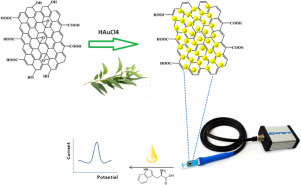当前位置:
X-MOL 学术
›
Microchem. J.
›
论文详情
Our official English website, www.x-mol.net, welcomes your
feedback! (Note: you will need to create a separate account there.)
A Novel Nanocomposite Electrochemical Sensor based on Green Synthesis of Reduced Graphene Oxide/Gold Nanoparticles Modified Screen Printed Electrode for Determination of Tryptophan using Response Surface methodology Approach
Microchemical Journal ( IF 4.9 ) Pub Date : 2020-05-01 , DOI: 10.1016/j.microc.2020.104634 Somayeh Nazarpour , Reza Hajian , Mina Hosseini Sabzvari
Microchemical Journal ( IF 4.9 ) Pub Date : 2020-05-01 , DOI: 10.1016/j.microc.2020.104634 Somayeh Nazarpour , Reza Hajian , Mina Hosseini Sabzvari

|
Abstract In this study, a new method is presented for the direct determination of L-tryptophan (Try), using E. tereticornis leave as an environmentally friendly reducing agent for synthesis of reduced graphene oxide/gold nanoparticles (rGO/AuNPs). Scanning electron microscopy (FESEM), transmission electron microscopy (TEM), X-ray diffraction (XRD) and Raman spectroscopy analyses showed a uniform distribution of gold nanoparticles on thin layers of reduced graphene oxide. The synthesized nanocomposite was used as a sensitive and electroactive substrate on the surface of screen-printed electrode for electrochemical oxidation of Try in biological samples. Differential pulse voltammetry (DPV) and cyclic voltammetry (CV) showed a reliable analytical signal for the oxidation of Tryptophan at 0.65 V. Response surface methodology (RSM) model was utilized for improving the sensitivity of detection based on central composite design. Under the optimum conditions (Britton Robinson buffer, pH: 6.0; AuNPs/rGO ratio (W/W): 4 and drop casted nanocomposite volume: 5 µl), the calibration curve of Try is linear between 0.5–500 µmol/L (R = 0.9976) with detection limit (LOD) and limit of quantification (LOQ) of 0.39 and 1.32 µmol/L, respectively. In addition, the SPE/rGO/AuNPs electrochemical sensor showed good reproducibility, high sensitivity and good selectivity towards the determination of Try, which makes it suitable for the analysis of Try in human plasma, serum and saliva.
中文翻译:

基于绿色合成还原氧化石墨烯/金纳米颗粒改性丝网印刷电极的新型纳米复合电化学传感器,用于使用响应面法测定色氨酸
摘要 在本研究中,提出了一种直接测定 L-色氨酸 (Try) 的新方法,使用 E. tereticornis 叶作为环境友好的还原剂合成还原氧化石墨烯/金纳米粒子 (rGO/AuNPs)。扫描电子显微镜 (FESEM)、透射电子显微镜 (TEM)、X 射线衍射 (XRD) 和拉曼光谱分析表明,金纳米粒子在还原氧化石墨烯的薄层上分布均匀。合成的纳米复合材料用作丝网印刷电极表面的敏感和电活性基材,用于生物样品中 Try 的电化学氧化。微分脉冲伏安法 (DPV) 和循环伏安法 (CV) 在 0.65 V 下显示出可靠的色氨酸氧化分析信号。响应面法(RSM)模型用于提高基于中心复合设计的检测灵敏度。在最佳条件下(Britton Robinson 缓冲液,pH:6.0;AuNPs/rGO 比(W/W):4 和滴铸纳米复合材料体积:5 µl),Try 的校准曲线在 0.5–500 µmol/L 之间呈线性(R = 0.9976),检测限 (LOD) 和定量限 (LOQ) 分别为 0.39 和 1.32 µmol/L。此外,SPE/rGO/AuNPs电化学传感器对Try的测定表现出良好的重现性、高灵敏度和良好的选择性,使其适用于人血浆、血清和唾液中Try的分析。4 和滴铸纳米复合材料体积:5 µl),Try 的校准曲线在 0.5–500 µmol/L (R = 0.9976) 之间呈线性,检测限 (LOD) 和定量限 (LOQ) 为 0.39 和 1.32 µmol/L , 分别。此外,SPE/rGO/AuNPs电化学传感器对Try的测定表现出良好的重现性、高灵敏度和良好的选择性,使其适用于人血浆、血清和唾液中Try的分析。4 和滴铸纳米复合材料体积:5 µl),Try 的校准曲线在 0.5–500 µmol/L (R = 0.9976) 之间呈线性,检测限 (LOD) 和定量限 (LOQ) 为 0.39 和 1.32 µmol/L , 分别。此外,SPE/rGO/AuNPs电化学传感器对Try的测定表现出良好的重现性、高灵敏度和良好的选择性,使其适用于人血浆、血清和唾液中Try的分析。
更新日期:2020-05-01
中文翻译:

基于绿色合成还原氧化石墨烯/金纳米颗粒改性丝网印刷电极的新型纳米复合电化学传感器,用于使用响应面法测定色氨酸
摘要 在本研究中,提出了一种直接测定 L-色氨酸 (Try) 的新方法,使用 E. tereticornis 叶作为环境友好的还原剂合成还原氧化石墨烯/金纳米粒子 (rGO/AuNPs)。扫描电子显微镜 (FESEM)、透射电子显微镜 (TEM)、X 射线衍射 (XRD) 和拉曼光谱分析表明,金纳米粒子在还原氧化石墨烯的薄层上分布均匀。合成的纳米复合材料用作丝网印刷电极表面的敏感和电活性基材,用于生物样品中 Try 的电化学氧化。微分脉冲伏安法 (DPV) 和循环伏安法 (CV) 在 0.65 V 下显示出可靠的色氨酸氧化分析信号。响应面法(RSM)模型用于提高基于中心复合设计的检测灵敏度。在最佳条件下(Britton Robinson 缓冲液,pH:6.0;AuNPs/rGO 比(W/W):4 和滴铸纳米复合材料体积:5 µl),Try 的校准曲线在 0.5–500 µmol/L 之间呈线性(R = 0.9976),检测限 (LOD) 和定量限 (LOQ) 分别为 0.39 和 1.32 µmol/L。此外,SPE/rGO/AuNPs电化学传感器对Try的测定表现出良好的重现性、高灵敏度和良好的选择性,使其适用于人血浆、血清和唾液中Try的分析。4 和滴铸纳米复合材料体积:5 µl),Try 的校准曲线在 0.5–500 µmol/L (R = 0.9976) 之间呈线性,检测限 (LOD) 和定量限 (LOQ) 为 0.39 和 1.32 µmol/L , 分别。此外,SPE/rGO/AuNPs电化学传感器对Try的测定表现出良好的重现性、高灵敏度和良好的选择性,使其适用于人血浆、血清和唾液中Try的分析。4 和滴铸纳米复合材料体积:5 µl),Try 的校准曲线在 0.5–500 µmol/L (R = 0.9976) 之间呈线性,检测限 (LOD) 和定量限 (LOQ) 为 0.39 和 1.32 µmol/L , 分别。此外,SPE/rGO/AuNPs电化学传感器对Try的测定表现出良好的重现性、高灵敏度和良好的选择性,使其适用于人血浆、血清和唾液中Try的分析。











































 京公网安备 11010802027423号
京公网安备 11010802027423号